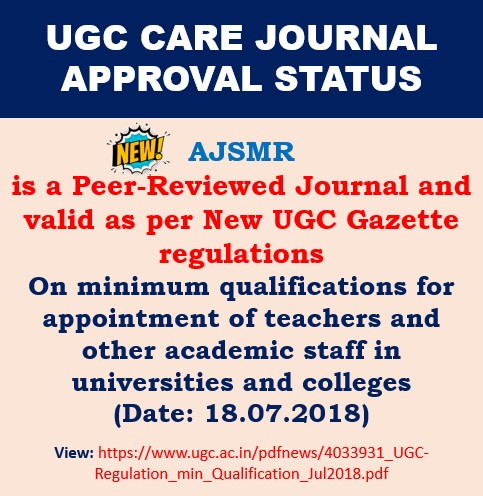Original Research Article I Volume 3 I Issue 3 I 2017
Medicinal Plants Used By Traditional Medicine Practitioners In The Management Of HIV/AIDS-Related Diseases In Tribal Areas Of Adilabad District, Telangana Region
Swapna Gurrapu and Estari Mamidala
The American Journal of Science and Medical Research; 3(3); 1-7
DOI:http://dx.doi.org/10.17812/ajsmr3301
Abstract:
Sexually transmitted infections have been of major concern recently due to their association with the Human Immunodeficiency Virus and Acquired Immunity Deficiency Syndrome (HIV/AIDS). The study area (tribal areas of Adilabad district) has the highest HIV infection rate in Telangana region of India, which made them more prone to a wide range of infections. Information was obtained from the traditional healers and other experienced persons, having some knowledge on medicinal plants. A total of seven lay people, were interviewed on their knowledge of medicinal plants used to treat symptoms of HIV and opportunistic infections like diarrhoea, coughing, malaria, skin rashes and tuberculosis. Forth-three plant species from 31 families were recorded in the present survey for the treatment of 7 different infections and symptoms of HIV disease. The most plant parts used were leaves (32.5%), followed by fruits (25.5%), seeds (18.6%), bark (13.95%), whole plant (9.3%) and stem (6.7%). Leaves ranked the highest, especially for use in topical preparations. Oral administration was the most frequently used route of administration. Further research is needed to isolate and identify the active chemical compounds present in those plants and understand their modes of action.
Keywords:
HIV/AIDS, Adilabad, Traditional healers, Telangana, Sexually transmitted Infections
References:
[1]. Abbink J, Medicinal & ritual plants of the Ethiopian South West: An account of recent research, Indigenous knowledge and development monitor, 32 (1995) 6–8.
[2]. Abo KA, Adeite DA, Ethnobotanical survey of medicinal plants used in the treatment of infertility and STD in South West Nigeria, African Journal Medicinal Sciences, 29 (2000) 325-327.
[3]. Ajibesin K.K, Ethnobotanical survey of plants used for skin diseases and related ailments in Akwa Ibom State, Nigeria. Ethnobotany Research and Applications ,10 (2012 ) 463–522.
[4]. Allabi A.C, Dossa R, Djeigo J.G , Yombi J.C, Diombo K, Bigot A & Giambattista P, (2012). Effectiveness of the medicinal plant R019 in the treatment of HIV infection: An observational study. Journal of Applied Pharmaceutical Science 2(2):59–65.
[5]. Ankli A, Yucatic Mayan medicinal plants: evaluation based on indigenous uses. Journal of Ethnopharmacology( 2002) 79, 43- 53.
[6]. Botsaris AS,Plants used traditionally to treat malaria in Brazil: the archives of Flora Medicinal. J Ethnobio Ethnomed 3(18), ( 2007).
[7]. Burnett A, Baggaley R, Ndovi-MacMillan M, Sulw J, Hang’Omba B and Bennett J, Caring for people with HIV in Zambia, are traditional healers and formal health workers willing to work together, AIDS Care, 11 (4) (1999) 481–491.
[8]. Cataldo F, Kielmann K, Kielmann T, Mburu G, and Musheke M, “‘Deep down in their heart, they wish they could be given some incentives’: a qualitative study on the changing roles and relations of care among home-based caregivers in Zambia,” BMC Health Services Research, vol. 15, article 36, 10 pages, (2015).
[9]. Chinsembu K.C & Hedimbi M, An ethnobotanical survey of plants used to manage HIV/AIDS opportunistic infections in Katima Mulilo, Caprivi region, Namibia. Journal of Ethnobiology and Ethnomedicine 6(25 ) (2010 ).dx.doi. org/10.1186/1746-4269-6-25
[10]. Diallo D, Hveem B, Md. MA, Betge G, Paulsen BS, Maiga A, An ethnobotanical survey of herbal drugs of Gourma dist., Mali. Pharmaceutical Biology 37, ( 1999)80-91....
Article Dates:
Received: 30 May 2017; Accepted: 2 July 2017; Published: 12 July 2017
How To Cite:
Swapna Gurrapu and Estari Mamidala (2016). Medicinal Plants Used By Traditional Medicine Practitioners In The Management Of HIV/AIDS-Related Diseases In Tribal Areas Of Adilabad District, Telangana Region. The Ame J Sci & Med Res, 3(3):1-7. doi:10.17812/ajsmr3301.



